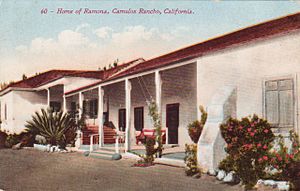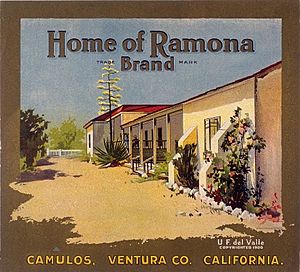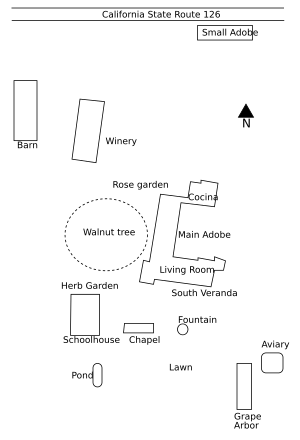Rancho Camulos facts for kids
|
Rancho Camulos
|
|
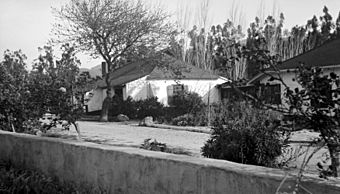
A view of Rancho Camulos from the northwest.
|
|
| Location | 5164 East Telegraph Road, Piru, California |
|---|---|
| Built | 1853 |
| Architectural style | Spanish Colonial Mission Revival Spanish Colonial Revival |
| NRHP reference No. | 96001137 |
Quick facts for kids Significant dates |
|
| Added to NRHP | November 1, 1996 |
| Designated NHL | February 16, 2000 |
Rancho Camulos, also known as the Rancho Camulos Museum, is a historic ranch in the Santa Clara River Valley in Ventura County, California. It's about 2.2 miles (3.5 km) east of Piru, California, and close to the Santa Clara River. This ranch was once the home of Ygnacio del Valle, an important leader in Pueblo de Los Angeles in the 1800s. He was also elected to the California State Assembly.
Rancho Camulos became famous as the "Home of Ramona." Many people believed it was the setting for the popular 1884 novel Ramona by Helen Hunt Jackson. This book helped people learn about the "Californio" way of life. It also made the "mission and rancho era" of California history seem very romantic.
This 1,800-acre (7.3 km²) working ranch shows what an early California rancho was like. It was the first place in Ventura County to grow oranges for sale. Today, it's one of the few places still growing citrus fruits in Southern California.
State Route 126 cuts through the property. Most of the main buildings are south of the highway. The main adobe house is one of the few original Spanish Colonial buildings left in California. Other buildings on the ranch are built in the Mission Revival or Spanish Colonial Revival styles. These styles were inspired by the older Spanish Colonial look.
Rancho Camulos is a very important historical site. It's a National Historic Landmark, listed on the National Register of Historic Places, and a California Historical Landmark. Many of the buildings and grounds are open to the public. You can visit them as a museum to learn about this time in California's past.
Contents
Exploring Rancho Camulos History
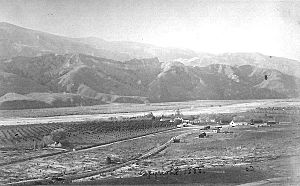
Early Days and Spanish Explorers
In 1769, the Spanish Portola expedition explored inland California. They camped by the Santa Clara River on August 10. Their exact spot is unknown, but it was in the area that later became Rancho Camulos. A missionary with them, Fray Juan Crespi, named the valley Cañada de Santa Clara.
The local Tataviam people had a village here called Kamulus, which means "juniper". As early as 1804, Mission San Fernando Rey de España used this area for growing crops and grazing animals. This isolated area was mainly traveled by the El Camino Real. In 1839, 416 people lived here.
The Del Valle Family and the Ranch's Beginnings
The land was part of the 48,612-acre (196.7 km²) Rancho San Francisco. This large area was given to Antonio del Valle, who managed Mission San Fernando, in 1839. This happened after the missions were no longer controlled by the church.
After Antonio died in 1841, his son Ygnacio inherited Rancho San Francisco. In 1853, Ygnacio built a four-room adobe house and a corral at Camulos. By 1857, a land dispute was settled. Ygnacio received the western part of the land. He then bought more land from his family and the nearby Rancho Temescal. He started raising livestock on his expanded ranch.
The Del Valle family didn't live at Camulos at first. They lived in Los Angeles. José Antonio Salazar, Del Valle's manager, oversaw the ranch. The main house was built after California became part of the United States. The Del Valle family never lived there when California was under Mexican rule.
Growth and Challenges of the Ranch
In the 1860s, a drought forced Del Valle to sell much of his land. But he kept Camulos and it thrived. By the time he died in 1880, the house had grown to twenty rooms. The ranch was like a small town, with a brick winery, a chapel, a barn, and homes for workers. Records show that in 1870, the ranch was the biggest vintner (wine producer) in the area.
A stagecoach line started in 1874. In 1887, the Southern Pacific built a rail line right past the ranch, with a station at Camulos. This ended the ranch's isolation.
New Owners and Restoration Efforts
In 1908, Ygnacio's children formed the Del Valle Company. But by 1924, they sold the ranch to August Rübel from Zürich, Switzerland. The Los Angeles Times wrote that it was the end of an era. The Del Valles were said to be the last old Spanish family to keep their ancestral land.
Rübel kept running the ranch like the Del Valles, even keeping many of the same workers. He died in 1943 while serving in World War II. After his death, his widow, Mary, married Edwin Burger. He wasn't as interested in keeping up the rancho. After Mary died in 1968, Burger closed the ranch. The buildings were left uncared for.
Rübel's family got the property back after the 1994 Northridge earthquake, which damaged some buildings. They started growing citrus again and repaired the earthquake damage. In 1996, Camulos was listed on the National Register of Historic Places. In 2000, it became a National Historic Landmark. The main house was restored in 1996, and smaller buildings were fixed by 2007.
The ranch is on State Route 126, but you can't see much from the road. The driveway and parking lot were used for filming the 1970 science-fiction TV movie The Love War.
Farming at Rancho Camulos
Ygnacio del Valle got his first Valencia orange trees in 1857. The fruit from these trees was the first to be grown for sale in what is now Ventura County. At first, it was a small operation because the oranges had to be taken by wagon to Los Angeles. A Southern Pacific train line opened in 1876, making transport easier.
However, the main crop at Rancho Camulos was wine. In the 1860s, 90 acres (360,000 m²) of vineyards were planted. Camulos wines and brandies were well-known. In 1870, Camulos was the biggest wine producer in the area. They grew 45 tons (40,900 kg) of grapes, making 6,000 US gallons (23,000 L) of wine and 800 US gallons (3,000 L) of brandy.
Besides oranges and grapes, the ranch grew almonds, walnuts, apricots, wheat, corn, and barley. Rose petals from Camulos were even sent to Europe to make perfume.
Over time, other fruits replaced the vineyards. Today, about 600 acres (2.4 km²) are farmed, mostly oranges. But lemons, grapefruit, and avocados are also grown. This makes Camulos one of the few citrus farms still operating in the area. After World War II, many citrus farms in Southern California were replaced by new towns and cities. But the Santa Clara River Valley kept its citrus farms.
The Story of Ramona
How Rancho Camulos Inspired a Famous Novel
The novel Ramona, published in 1884, was partly based on what Helen Hunt Jackson saw when she visited Rancho Camulos in 1882. Jackson only spent two hours there and didn't meet Ysabel del Valle. But she noticed many small details and used them in her book. For example, the altar cloth in the ranch's chapel had a small mended tear. In the novel, a character accidentally tears the altar cloth, and Ramona sews it.
The book became very popular and brought many tourists to California. The new Southern Pacific railroad lines made it easier for people to visit.
Many towns claimed to be the setting for the novel to attract tourists. But the fictional Moreno Ranch, described as being between the lands of Mission San Fernando and Mission San Buenaventura, matches Rancho Camulos. Also, some of the buildings in the book sound just like those at Camulos. However, other parts of the story, like Ramona getting married in San Diego, make Camulos seem too far away to be the exact spot. Jackson died in 1885 and never said publicly which places inspired her book.
By 1886, many readers already thought Camulos was the setting. Edward Roberts wrote an article called "Ramona's Home: A Visit to the Camulos Ranch..." in the San Francisco Chronicle. This article mixed facts with fiction. It was even added to later versions of the novel, which made the connection even stronger.
Promoting the "Home of Ramona"
The first book just about Ramona and the ranch was published in 1888 by Charles Fletcher Lummis. He was a friend of the Del Valles. Lummis took photos of the buildings and published them in his book, Home of Ramona: Photographs of Camulos.... He showed that the Del Valles were not like the fictional Morenos, who treated Ramona badly. But he also mixed fact with fiction. For example, he wrote that the veranda ran from Father Salvierderra's room to Ramona's room.
Lummis wanted to make sure Camulos was seen as the true "Home of Ramona." Adam Clark Vroman's book, Ramona Illustrated, also compared photos of the ranch with parts of the novel. By 1909, George Wharton James could confidently say that Camulos was the "accepted home of the heroine."
Even though it was hard to get to the ranch and there were no hotels nearby, tourists still came. The railroad even used the ranch in its ads. The Del Valles, known for their hospitality, would let visitors stay. But by 1888, it became very expensive. Tourists could also be a problem, sometimes stealing souvenirs or fruit.
The name Camulos became so linked to the novel that people started using it instead of "Moreno Ranch." A play based on the book in 1897 was called "Ramona, or the Bells of Camulos."
D. W. Griffith filmed parts of his 1910 silent film at the rancho. He used the chapel, adobe house, patio, and nearby mountains as backdrops. Famous artists also painted and photographed the rancho, and their works appeared in later versions of the novel.
The Del Valles used their new fame to their advantage. They branded their wine and oranges as the "Home of Ramona Brand." Their labels showed the same veranda view seen on postcards. One Tataviam servant girl even made money by pretending to be the "real Ramona" and charging tourists for photos.
Tourists kept coming even after the main train line moved in 1903. Two daily trains still stopped at Camulos until the 1940s, when cars became the main way to travel. After the Rübels bought the ranch in 1924, they still welcomed small groups of visitors. They turned the second floor of the winery into a small museum with items from the Del Valle family. Today, the rancho hosts an annual "Ramona Days" festival in October.
Exploring the Rancho Camulos Grounds
Fifteen buildings at Rancho Camulos are open to the public as part of the museum. All of them were built before 1930 and are still in their original spots. Most were built in Spanish Colonial or Mission Revival styles. The ranch also has lawns, flower gardens, and walkways that separate the homes from the working areas.
The Main Adobe House
The main adobe, also called the Ygnacio del Valle adobe, is a huge, U-shaped building with twenty rooms. It's about 10,000 square feet (929 m²). When it was first built in 1853, it was L-shaped with four rooms and an outside corredor (a covered walkway), which was common for Spanish Colonial homes. This style was unusual for the time, as the Monterey style was more popular. Other historic ranches like Los Alamos Ranch House, Rancho Guajome Adobe, and Las Flores Adobe are built in a similar style.
The house grew in several stages. In 1861, three more rooms were added, along with a separate cocina (kitchen). This kept fire away from the main house and kept it cooler. In the 1870s, another section was added. After 1895, one more room and a breezeway to the kitchen completed the current shape. Any changes after that were only to the inside.
The basement of the house was first used to store wine. In 1867, a brick winery was built. After 1900, when wine grapes were no longer grown for sale, this building became a storage room. Later, Rübel turned it into a museum for Ramona visitors, filled with Del Valle family items. Today, it stores farm equipment and cars.
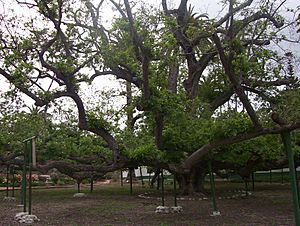
West of the main house is a very large California Black Walnut (Juglans californica) tree. It was probably planted by Juventino del Valle in the 1860s. It's about 25 feet (7.6 m) around and its branches spread over almost half an acre (2,000 m²). It's thought to be the biggest Black Walnut tree in the area.
The Chapel and Other Buildings
The wooden chapel was built around 1867, replacing an earlier, simpler chapel. After the missions were no longer controlled by the church, this chapel became known as the "lost mission." It was the only place to worship between Mission San Fernando and Mission San Buenaventura.
Next to the chapel is a bell structure. It originally held three bells. These bells were used to call people to Mass. The largest bell and a slightly smaller one were made in Kodiak, Alaska. The smaller one had been used at Mission San Fernando and may have been moved to Camulos by Antonio del Valle. The third, smallest bell is missing.
The exact dates for the barn, gas station, and bunkhouse are not known. But their American Craftsman style suggests they were built between 1910 and 1916. The barn is in the main work area, northwest of the living quarters.
The small adobe house, near the highway, was built by Nachito del Valle. This Spanish Colonial Revival house was built around 1920. It was badly damaged in the 1994 earthquake. After it was rebuilt, it became the museum's visitor center.
The schoolhouse, built in 1930, was the last building added to the property. Rübel built it for his family and his bookkeeper's family. It was designed to look like the main adobe.
Few buildings are left on the north side of the highway. The most notable are the wooden Southern Pacific saltbox-style section house and workers' bunkhouse, both built in 1887. A train depot and post office used to be here but have been torn down. Three farmworkers' bungalows, built by the Del Valle family in 1916, are west of the section house.
Historic Designations
- United States National Historic Landmark – added February 16, 2000
- United States National Register of Historic Places – reference number 96001137, added November 1, 1996
- California Historical Landmark – number 553
See also
- List of Registered Historic Places in Ventura County, California
- Ventura County Historic Landmarks & Points of Interest
- List of ranchos of California




